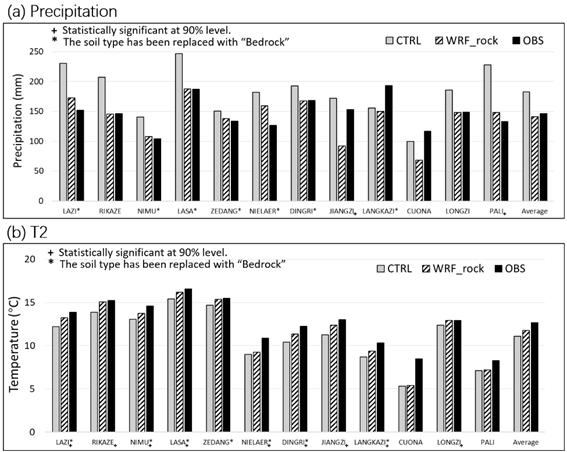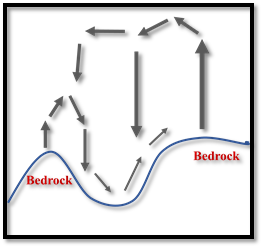In October 2021, the research group led by Professor Yang Kun from the Department of Earth System Science of Tsinghua University published a paper entitled “Presentation of Stony Surface-Atmosphere Interactions in WRF Reduction Cold and Wet Bias for the Southern Tibetan Plateau” in the Journal of Geophysical Research: Atmospheres. In the field investigation, the research group found that the surface in the Southern Tibetan Plateau is mostly composed of bedrock. While in WRF model, the soil type of this area is set as loam. Different soil types will affect the allocation of sensible and latent heat fluxes due to different hydrothermal characteristics, thus resulting in different local circulation changes. Therefore, the research group identified the bedrock in the Southern Tibetan Plateau with satellite data, and corrected the soil type in WRF model, thus significantly improving the cold and wet bias of model simulation, and explored related physical process. This study will promote the application of satellite data in model simulation for areas of complex terrain.
In this study, the domain of bedrock are identified with the normalized differential vegetation index (NDVI) provided by satellite data and the terrain standard deviation data in the model. Specifically, the following two indexes are used to identify bedrock: (1) NDVI <0.3, and (2) terrain standard deviation > 100m. When both conditions are met, the studied area is considered to be sparsely covered with vegetation and the terrain there is not conducive to vegetation growth, so the soil type of this area is set as bedrock. After the soil type is corrected, the simulation results of July 2017 (as an example) show that the simulation bias of average monthly precipitation at 12 weather stations is reduced from 35mm to -6mm, and that of average air temperature at the height of 2m is reduced from 1.5°C to 0.8°C (Fig. 1).

Fig. 1 Comparison between the Results of CTRL and WRF_rock Tests in July 2017 and the Site Observation Data. (a) precipitation (mm) (b) average temperature at the height of 2m (°C). CTRL test is carried out based on the default soil type in WRF, and WRF_rock test is carried out based on the corrected soil type.
This study further explores the physical mechanism that the change of bedrock surface affects the simulation results of precipitation and temperature. Different from mineral soil, bedrock has a porosity close to zero, which greatly intensifies the difficulties of precipitation infiltration, increases surface runoff and reduce evaporation. As a result, there is insufficient water vapor in the atmosphere, which is not conducive to the formation of precipitation. With a low heat capacity, bedrock may see a rapid rise of surface temperature, which will increase the sensible heat and enhance the valley wind effect. This is not conducive to the formation of precipitation in the valley, but conducive to the rise of temperature (Fig. 2).

Fig. 2 Schematic Diagram of the Enhanced Valley Wind Effect after Correction of the Soil Type
Yue Siyu, a doctoral student in the Department of Earth System Science of Tsinghua University, is the first author, and Professor Yang Kun is the correspondence author. The collaborators include Associate Professor Lu Hui from the Department of Earth System Science of Tsinghua University, Associate Researcher Zhou Xu from the Institute of Tibetan Plateau Research of Chinese Academy of Sciences, Professor Chen Deliang from the University of Gothenburg and Professor Guo Weidong from Nanjing University. This study has received the support from the National Key R&D Program of China (2018YFA0605400), the Basic Science Center for the Tibetan Plateau Earth System of the National Natural Science Foundation of China (41988101), the General Project of the National Natural Science Foundation of China (41905087) and the 13th Five-Year Informatization Plan of Chinese Academy of Sciences (XXH13505-06).
Paper link: https://agupubs.onlinelibrary.wiley.com/doi/epdf/10.1029/2021JD035291
Contributed by: Yue Siyu
Edited by: Wang Jiayin
Reviewed by: Huang Xiaomeng